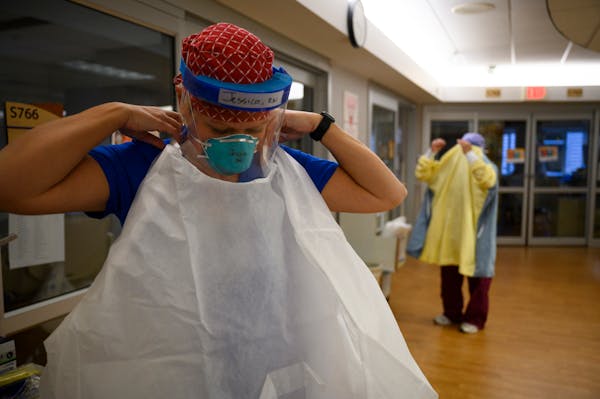A fast-spreading BA.5 variant might be the dominant source of coronavirus infections in Minnesota right now, but it hasn't fueled any uptick of serious COVID-19 illnesses in the state so far.
New infections have declined from more than 2,100 per day in mid-May to about 1,300 per day in the last week of June, according to the Minnesota Department of Health's weekly COVID-19 report on Thursday.
The 107 COVID-19 deaths identified in June so far are below the 161 in May and the 1,081 in December at the peak of this past winter's pandemic wave.
The latest COVID-19 hospitalization numbers in Minnesota have been unusual for their consistency in a pandemic that has been marked by dramatic waves over the past two years. The state reported 383 COVID-19 hospitalizations on Tuesday and has averaged 396 since May. The number of severe COVID-19 cases requiring intensive care was 34 on Wednesday and hasn't been above 50 or below 20 since early March.
BA.5 is behaving in Minnesota much as it did when the omicron subvariant of the coronavirus was discovered in South Africa. It is causing numerous infections, even in fully vaccinated people, but a lower rate of severe illness. Genomic sequencing has found BA.5 in 15% of COVID-19 specimens sampled over the past month, and sampling at the Metro Wastewater Treatment Plant in St. Paul found that it made up 43% of viral material in sewage last week.
Last year at this time, by comparison, a delta variant seized on gaps in vaccination coverage to fuel a severe COVID-19 wave that exhausted the state's supply of intensive care beds at its peak in December.
Health officials believe high immunity levels through recent infections and vaccinations have helped this summer. However, they remain concerned about the potential for waning immunity in people who received initial COVID-19 vaccinations months earlier. While 97% of vulnerable seniors completed the initial vaccine series, only 49% are considered up to date — meaning they have taken first and second boosters when recommended.
COVID-19 death rates have declined this summer among all age groups, but risks remain higher among seniors. They made up 17 of the 21 COVID-19 deaths identified in the week ending June 25. One death was reported that week among a child age 5 to 11, raising Minnesota's total in the pandemic to eight COVID-19 deaths among people younger than 18.
The state's count of infections has lost some relevance as a barometer of COVID-19 activity because it doesn't include results of increasingly popular at-home tests. Wastewater surveillance has emerged as an alternative.
Sewage sampling at 40 treatment plants, accounting for 67% of Minnesota's population, showed little overall change statewide, according to a University of Minnesota dashboard. Viral levels reported June 29 at 13 Twin Cities area treatment plants were 28% below peak levels in mid-May. Results for the Metro plant in St. Paul are reported separately on Fridays.
Carolyn Parnell, 'trailblazer' who served as Minnesota's first IT commissioner, dies

